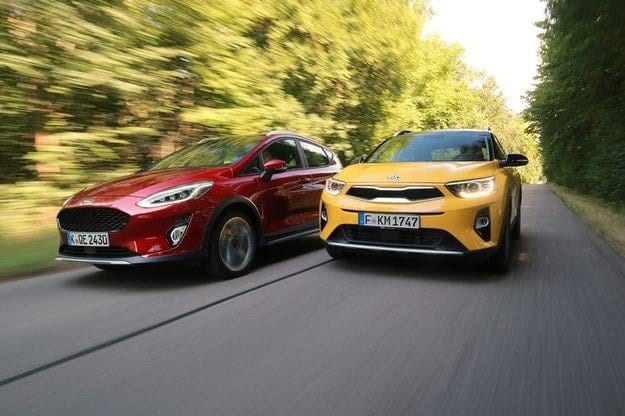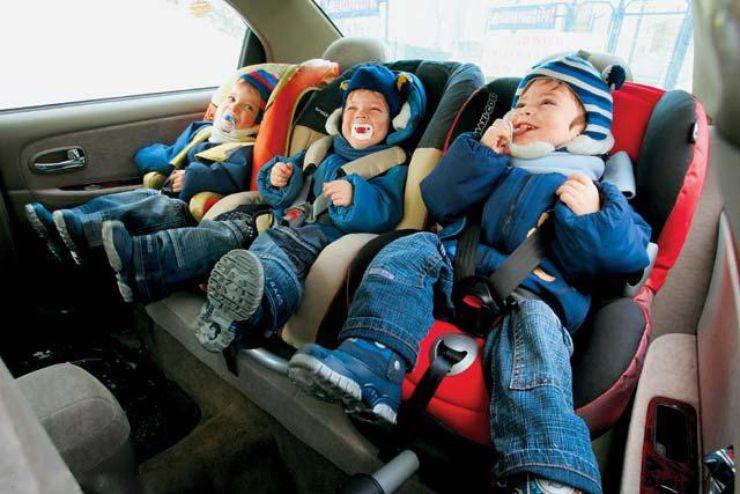
Test drive Ford Fiesta Active and Kia Stonic: three-cylinder turbochargers

Small crossovers with a liter turbo engine - be it a new joy on the road
In the small car category with increased ground clearance, the Ford Fiesta enters the ring with its new Active version. Kia Stonik is already waiting for her there as the first rival. We have tested both models.
We used to give dealers extra money to cover as much of the gray plastic in cars as possible, or to remove the body one finger closer to the pavement. And today, while the controversial suspension is still popular, there's a tendency to pay extra for hybrids raised off the road. The question arises - why? And especially in subcompact models.
The Ford Fiesta in the Active crossover and the Kia Stonic have only front-wheel drive, which is quite common in cars in this class. The higher-seat argument can be accepted with a friendly wink at the most - here passengers sit two to three centimeters higher than in regular Fiesta and Rio. And the extra clearance is enough for higher curbs, which is not entirely accurate. Therefore, their popularity is probably somehow connected with the so-called. lifestyle, right?
So, we headed to the climbing area, where we took the final shots with two crossovers. The real adventure for them begins only in our comfort test section, which does not yet have a few holes for the off-road test certification. Even the passage of a long wave with at least three spots leads to important observations: the Ford model rises higher on its springs, but waits a bit before descending relatively gently. Kia overcomes bumps more vigorously, but also with noticeable jolts and louder noise in the cabin.
Speaking of noise, although in acoustic measurements under the same driving conditions the results of the Stonic are almost on the same level, the subjective perception is often different, because aerodynamic noise and especially the engine are heard much more clearly. Here, as in the other car, under the hood is a one-liter three-cylinder engine with a sound spectrum, which some sporty four-cylinder models try to imitate with acoustic drives in order to get such a hard and strong accent. The Ford transmission radiates lower frequencies and remains more restrained overall.
Downsizing Cylinders
The small displacement in both cars is offset by turbochargers that generate the necessary torque - 172 Nm for the Stonic and eight more for the Fiesta. In both models, the maximum is reached at 1500 rpm, but under rather theoretical conditions. In practice, for example, when cornering at 15 km/h in second gear, the turbo mode will take a long time to really wake up.
However, during normal driving at higher speeds, both cars react to it very energetically, with some nuances depending on the current speed. Kia has a more spontaneous idea than the Fiesta, which, despite 20 horsepower, no longer accelerates to 100 km / h and is half a second behind the factory data. It is only on the track that the higher power becomes noticeable, albeit in moderation.
In terms of consumption, the two cars are also equal: just over seven liters per 100 km remain in good proportion to the power offered. If you don't necessarily want the most powerful engine, for 750 euros less you can get a 125 hp Fiesta Active. three-cylinder turbo engine.
We return to the intercity road. In multi-turn areas, the Ford model seems a little more agile thanks to the more direct steering, and if someone starts to turn smoothly, it's a Kia. And why is the Stonic so fast in slalom trials? The cars then dance between the cones at the thrust limit, and since Ford ESP cannot be completely disabled, it keeps the driver under its control at all times, losing not only time but also steering feel.
Good seats are not only desirable in such tests, but the standard Fiesta sports seats, while snug, don't offer much lateral support. On the other hand, your back benefits from an adjustable lumbar support that is generally not available on the wider Kia seats.
The interior design of the Korean company strictly focused on the virtues of compact cars of the 90s: solid polymers that, thanks to the thickness and quality of the surface, look incredibly durable and are processed as cleanly as in the Ford model. In some places, the plastic is thinly filled with foam, and there is even a little leather in the front door trim. In addition, decorative stripes have a slightly more luxurious carbon imitation shape and surround the screen.
The driver presses it more often because the physical buttons of the Sync 3 infotainment system are primarily used to control the music system. In Kia, they also lead to frequently used functions. On the other hand, you can only talk to the Stonic via Siri or Google, but the model supports Apple CarPlay and Android Auto in the basic version as standard (for Ford - for 200 euros). Connecting to a smartphone via the apps mentioned is seamless, so you can save €790 on a Kia navigation system. However, important digital radio reception (DAB) is also offered with it.
Kia doesn't offer some things
However, radar-based cruise control is out of the question, as it (like the €750 LED headlights) is only supplied to a young man from Cologne (€350 in security package II). Stonic offers only a simple speed control device, and the selected value is not displayed on the speedometer - a curious feature of some Asian cars.
The Fiesta Active also has this kind of cruise control. Her side mirrors and live ones are as small as they look in the photos. A highly recommendable blind spot warning system costs 425 euros, including lacquered mirror caps and electric motors for folding them.
The rear covers open without the support of an electric motor. Behind them, 311 can be loaded into the Fiesta, and 352 liters of luggage into the Stonic. A practical feature of both cars is the movable trunk floor. For the Fiesta, it costs 75 euros, but when loaded, it can stand upright, and then you can put a shelf under it to cover the trunk. In Stonic, you will have to find a place for this panel somewhere else.
Another original Ford feature is the door edge protector (€150), which automatically slides over the edge when opened and protects both the door and the car parked next door. The best seats, of course, are in the front row, but two adult passengers do not sit tightly in the back. However, the Kia's rear seat has slightly more dense padding.
Thus, the two adventurers are well equipped for everyday life, but, as we assumed at the beginning, there is no rational justification for raising prices over their conventional counterparts. The Fiesta will have to pay about 800 euros more for a similarly equipped version of the Active, while the Stonic will ask you for 2000 euros more than the price of the Rio. Against these, however, you get a completely separate case, not just different outer parts.
This may affect the purchase decision, but not necessarily. After all, a car should bring joy, and if it requires an additional payment, which is in a healthy ratio with the personal pleasure received, we will say - well, of course!
conclusion:
1. Ford Fiesta Active 1.0 Ecoboost Plus
402 points
And in the Active Fiesta version, it remains a comfortable, extremely balanced subcompact car and wins in all sections of this comparison except for the topic of cost.
2. Kia Stonic 1.0 T-GDI Spirit
389 points
If comfort is not so important to you, you will find a great alternative in the chic Stonic. However, there are no xenon or LED headlights here.
Text: Tomas Gelmancic
Photo: Hans-Dieter Zeifert
Home " Articles " Blanks » Ford Fiesta Active and Kia Stonic: three-cylinder turbochargers
